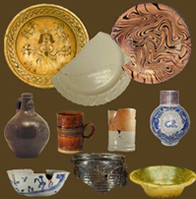
|
|
Jackfield - type Defining Attributes A fine earthenware with a thin purplish to gray body covered with a lustrous black glaze. Often decorated with molded designs and gilding. Chronology Jackfield developed in the 1740s and was most popular in the 1750s and 1760s, but "degenerate" versions continued to be made in small amounts into the 19th century (Barker and Halfpenny 1990:34-35). In the 1870s and 1880s, a revival of the Jackfield-type glaze occurred, this time on a terra cotta or white earthenware body. It is sometimes known as Jet Ware (Lewis 1999). Description Fabric Glaze Decoration Form Reference Barker and Halfpenny 1990; Lewis 1999; Noël Hume 1970, 2001.
|
|

|
Thank you for visiting our website. If you have any
questions, comments, Copyright © 2002 by |

|

 Click for all thumbnails
Click for all thumbnails